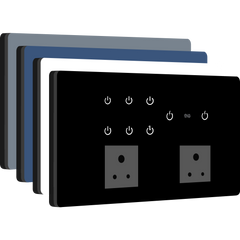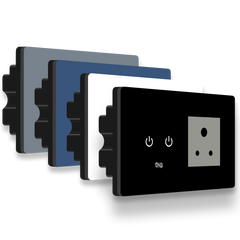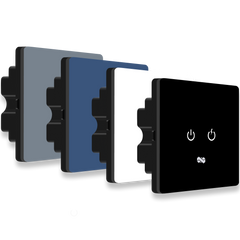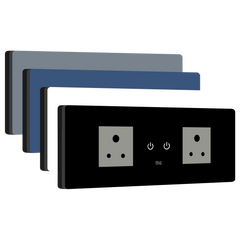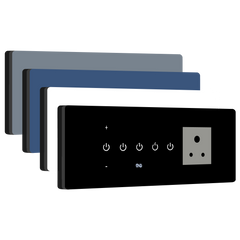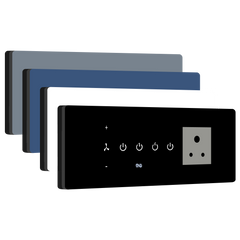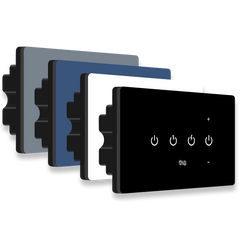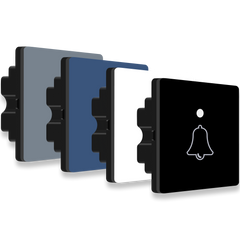Ready to upgrade your home with smart technology but unsure where to start? Don't worry; we've curated a comprehensive guide to ensure your installation of the 2P smart switch is smooth and hassle-free. Follow these detailed steps for a seamless and smarter living experience!
Installation Essentials:
Before you begin, gather these essential tools and materials:
- Insulated screwdrivers (star or flat)
- Insulated pliers
- Voltage tester
- Wire strippers
- Multimeter (optional)
- New smart switch
- Insulation tape
- Appropriate wires (based on load and requirements)
Ensure you have everything ready to proceed smoothly with the installation of your 2P smart switch.
Safety Tips for Smart Switch Installation:
- Read the smart switch instruction manual thoroughly.
- Turn off the main circuit breaker and double-check with a voltmeter.
- Use insulated tools and wear protective gloves.
- Clearly label all wires for easy identification.
- Ensure your workspace is dry and organised.
These steps will help ensure a safe and successful installation of your smart switch.
Module Compatibility and Console Box Specifications:
When preparing to install the 2P smart switch, understanding its compatibility and console box requirements is crucial for a successful setup:
Module Name: 2P
Console Box Size: 233 mm x 78 mm (9" x 3")
Module Specifications:
- Socket (P2, P3): 6A each
Installation and Wiring Guide:
- Turn off the power at the breaker box.
- Label the phase, neutral, earth, and other load wires in the wall console box.
- Study the terminal labels on the product's wiring sticker to ensure correct wire connections.
- Connect the wires to their designated terminals as indicated below:
- Neutral (N): Powers the device.
- Earth (E1, E2): Ground connections.
- Phase 1 (P1) UPS/EB: Primary power supply.
- Phase 2-3 (P2, P3) EB: Socket inputs.
- Check the wiring setup video for your specific type at home. Ensure all connections are correct, secure, and free of loose strands.
- Use insulation tape to secure exposed terminals and wire joints.
- Use a prying tool to carefully remove the glass panel without touching the circuit board.
- Insert the enclosure into the 8-module metal console box and secure it using the provided screws (M3.5*30mm).
- Align the top glass with the enclosure and press it firmly to lock it in place, ensuring that all four corners are securely locked.
- Restore power and test the switch for proper functionality.
If you need any device installation support or assistance, please call or WhatsApp.
Wiring Setup Scenarios:
Type 1: Two Power Sources (EB + UPS and Common Neutral)

- The phases for EB and UPS will remain separate.
- The neutral line will be common for both EB and UPS.
-
In the above scenario, the phase and neutral connections will be as follows:
- The UPS phase is connected to P1, providing power to the device.
- The EB phase is connected to P2, providing power to the plug and ensuring an earth point (E) is connected for the plug.
- The UPS phase is connected to P3, providing power to the plug and ensuring an earth point (E) is connected for the plug.
- The common neutral will be connected to N.
Type 2: Common Phase (EB or UPS and Common Neutral)

- The P1, P2, and P3 phases share the same phase line, either from the EB or UPS.
- The P1 phase is the primary power supply.
- Establish a loop connection from the P1 phase to the P2 and P3 phases to create a common phase line.
-
In this scenario, the phase and neutral connections will be as follows:
- The EB or UPS phase is connected to P1, providing power to the device.
- The P1 phase is looped to P2, supplying power to the plug, and ensuring an earth point (E) is connected for the plug.
- The P1 phase is looped to P3, supplying power to the plug, and ensuring an earth point (E) is connected for the plug.
- The common neutral will be connected to N.
Type 3: Common Phase(EB or UPS) but different Load Capacity

- The P1, P2, and P3 phases share the same phase line but have different load capacities, such as 6A and 16A, respectively.
- The P1 phase is the primary power supply.
-
In this scenario, the phase and neutral connections will be as follows:
- P1 is responsible for 6A load variants. The EB or UPS phase is connected to P1, providing power to the device.
- The P1 phase is looped to P3, supplying power to the plug and ensuring an earth point (E) is connected for the plug.
- P2 is responsible for 16A load variants. The EB phase is connected to P2, supplying power to the plug, and ensuring an earth point (E) is connected for the plug.
- The common neutral will be connected to N.


